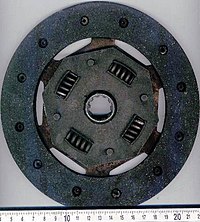
Photo from wikipedia
Abstract Cu-Al bimetallic composite plates with a thickness of 2 mm were prepared by a horizontal continuous composite casting-rolling process. The effects of rolling parameters on the forming performance of… Click to show full abstract
Abstract Cu-Al bimetallic composite plates with a thickness of 2 mm were prepared by a horizontal continuous composite casting-rolling process. The effects of rolling parameters on the forming performance of Cu-Al composite plates and the interface evolution mechanisms were investigated. The results reveal that a suitable deformation temperature and an increase in first-pass deformation are both conducive to enhancing bimetallic deformation coordination. For cold rolling, the first-pass reduction should exceed 60 % to avoid delamination cracking. When the rolling temperature rises to 200–300 °C, the first-pass reduction can be decreased to 55 % due to the better deformation coordination of bimetallic. However, an excessive rolling temperature results in the formation of a continuous layer of intermetallic compounds at the new interface, and the formability of the plates is decreased significantly. In the rolling process of Cu-Al composite plates, the original Cu-Al interface is first shattered, and then the matrix metal flows into the gaps of the broken interface. Finally, a new oxidation-free interface at the atomic scale is developed, which is beneficial to the bonding strength of the composite plates. The Cu-Al composite sheets prepared by the above reasonable parameters exhibit a tensile strength of 180–191 MPa, an elongation of 8%–12 %, and an excellent interfacial bonding strength of 66–89 MPa.
Journal Title: Journal of Materials Processing Technology
Year Published: 2021
Link to full text (if available)
Share on Social Media: Sign Up to like & get
recommendations!